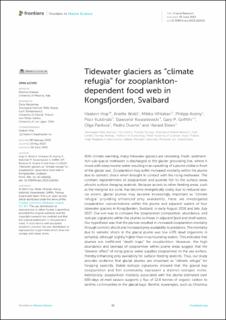| dc.description.abstract | With climate warming, many tidewater glaciers are retreating. Fresh, sediment-rich sub-glacial meltwater is discharged at the glacier grounding line, where it mixes with deep marine water resulting in an upwelling of a plume visible in front of the glacial wall. Zooplankton may suffer increased mortality within the plume due to osmotic shock when brought in contact with the rising meltwater. The constant replenishment of zooplankton and juvenile fish to the surface areas attracts surface-foraging seabirds. Because access to other feeding areas, such as the marginal ice zone, has become energetically costly due to reduced sea-ice extent, glacial plumes may become increasingly important as “climate refugia” providing enhanced prey availability. Here, we investigated zooplankton concentrations within the plume and adjacent waters of four tidewater glaciers in Kongsfjorden, Svalbard, in early August 2016 and late July 2017. Our aim was to compare the zooplankton composition, abundance, and isotopic signatures within the plumes to those in adjacent fjord and shelf waters. Our hypothesis was that the plumes resulted in increased zooplankton mortality through osmotic shock and increased prey availability to predators. The mortality due to osmotic shock in the glacial plume was low (<5% dead organisms in samples), although slightly higher than in surrounding waters. This indicates that plumes are inefficient “death traps” for zooplankton. However, the high abundance and biomass of zooplankton within plume areas suggest that the “elevator effect” of rising glacial water supplies zooplankton to the sea surface, thereby enhancing prey availability for surface-feeding seabirds. Thus, our study provides evidence that glacial plumes are important as “climate refugia” for foraging seabirds. Stable isotope signatures showed that the glacial bay zooplankton and fish community represent a distinct isotopic niche. Additionally, zooplankton mortality associated with the plume estimated over 100-days of melt season supports a flux of 12.8 tonnes of organic carbon to benthic communities in the glacial bays. Benthic scavengers, such as Onisimus caricus and Anonyx nugax, were abundant in the glacial bay, where they feed on sinking organic matter. | en_US |
